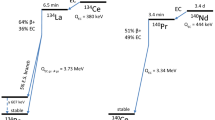Abstract
To determine the effects of 211At-labelled antibodies in solid tumour tissue, nude mice carrying OHS human osteosarcoma xenografts received intratumour injections at dosages of 1, 2 or 4 MBq (-1) tumour. The radioisotope was conjugated to either the osteosarcoma-specific monoclonal antibody TP-3 or the non-specific polyclonal antibody hlgGkappa. Tumour retention of injected radioimmunoconjugate (RIC), measured as the percentage of injected activity dosage per gram, was significantly higher for the [211At]TP-3 (203 +/- 93 at 24.1 h post injection) compared with the [211At]hlgGkappa (57 +/- 22 at 23.2 h post injection). The radioactive count rates in body (measured at neck and abdomen) were significantly lower with the TP-3 than with the hlgGkappa. Microautoradiography of the tumour radionuclide distribution was different for the two RICs, i.e. the [211At]TP-3 was to a larger extent concentrated near the injection site, whereas the [211At]hlgGkappa was more evenly distributed all over the tumour. The tumour growth was significantly delayed as a function of the injected activity dosage but without significant difference between the specific and the non-specific RIC. According to this study, it is possible to deliver highly selective radiation doses to solid tumours using intratumour injection of alpha-particle-emitting RICs. Improved tumour retention caused by antigen binding indicates that reduced normal tissue exposure can be obtained with antigen-specific antibodies. The heterogeneous tumour dose distribution observed is, however, a major impediment to the use of alpha-particle emitters against solid tumours.
This is a preview of subscription content, access via your institution
Access options
Subscribe to this journal
Receive 24 print issues and online access
$259.00 per year
only $10.79 per issue
Buy this article
- Purchase on Springer Link
- Instant access to full article PDF
Prices may be subject to local taxes which are calculated during checkout
Similar content being viewed by others
Author information
Authors and Affiliations
Rights and permissions
About this article
Cite this article
Larsen, R., Bruland, O. Intratumour injection of immunoglobulins labelled with the α-particle emitter 211At: analyses of tumour retention, microdistribution and growth delay. Br J Cancer 77, 1115–1122 (1998). https://doi.org/10.1038/bjc.1998.185
Issue Date:
DOI: https://doi.org/10.1038/bjc.1998.185
This article is cited by
-
One-step labelling of a novel small-molecule peptide with astatine-211: preliminary evaluation in vitro and in vivo
Journal of Radioanalytical and Nuclear Chemistry (2018)
-
Cancer radioimmunotherapy with alpha-emitting nuclides
European Journal of Nuclear Medicine and Molecular Imaging (2005)
-
Eingeladener Kommentar zu: „Radioimmuntherapie — Ergebnisse und Entwicklungsmöglichkeiten“
European Surgery (1999)



